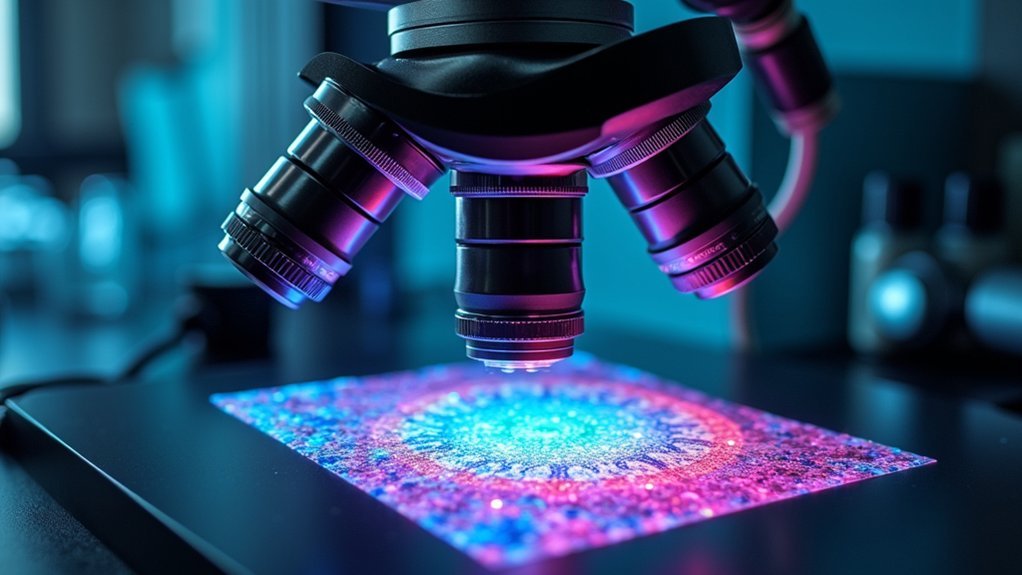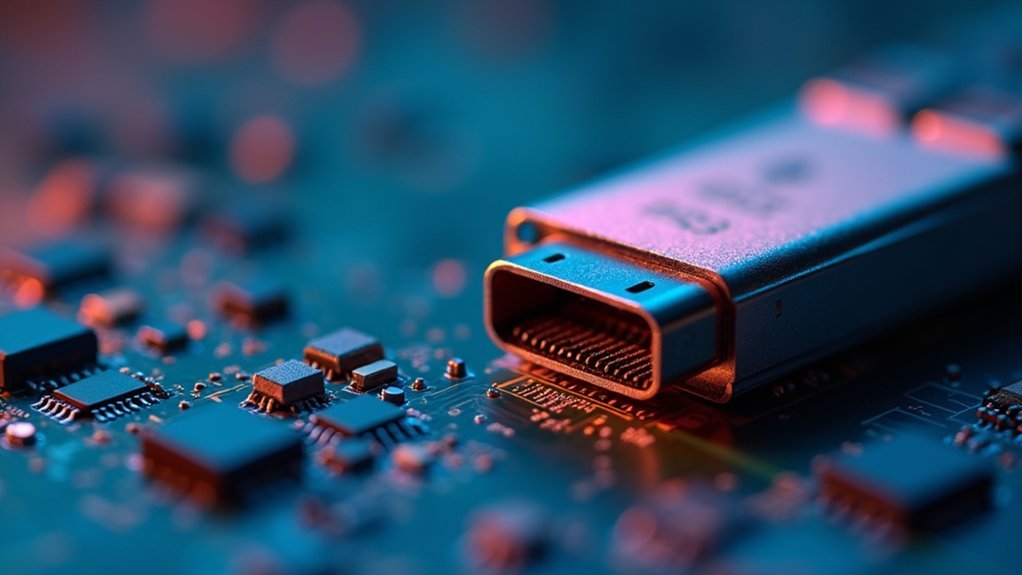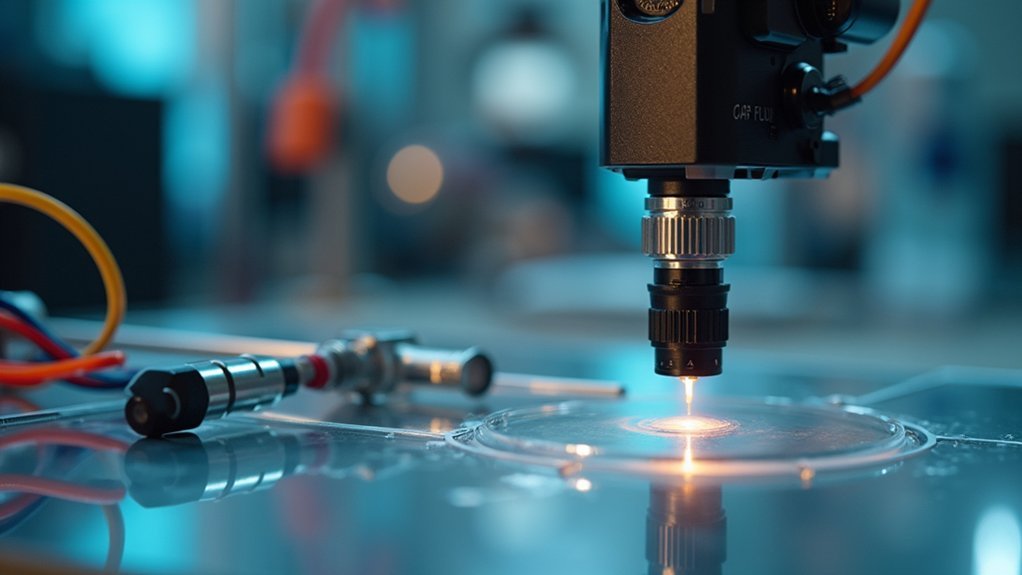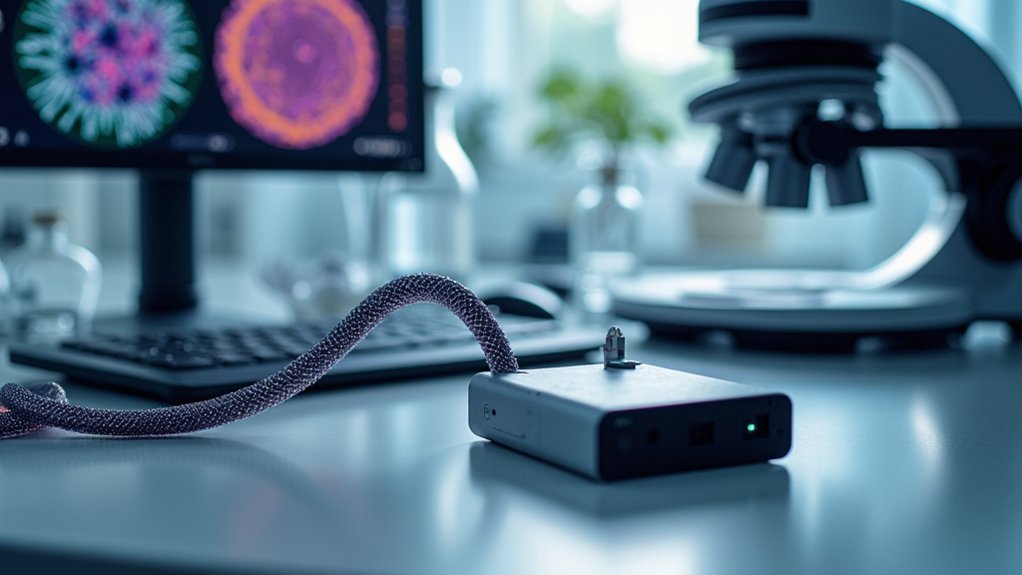Digital adapters transform scientific photo documentation by converting traditional microscopes into powerful digital imaging systems. You’ll capture high-resolution images (1.3-5MP) with superior clarity and true color representation through improved lighting and calibration. These tools enable instant sharing with colleagues worldwide, streamlined workflow integration, and enhanced measurement precision that eliminates estimation errors. The seamless connectivity to computers and cloud platforms dramatically improves research collaboration and productivity. Discover how these affordable upgrades can revolutionize your laboratory documentation processes.
The Evolution From Analog to Digital Microscopy

While traditional optical microscopes have served scientists faithfully for centuries, the evolution from analog to digital microscopy represents a quantum leap in image quality and documentation capabilities.
You’ll notice immediately how digital photography eliminates the limitations of conventional setups, providing enhanced resolution and clarity that transforms your research experience.
With eyepiece cameras like Dino-Eye, you’re no longer constrained by what you can see through narrow eyepieces.
These digital adapters, offering 1.3 to 5 megapixel resolution, convert your standard microscope into a powerful image capture platform.
Your workflow becomes more efficient as you view specimens on larger screens, reducing eye strain during long sessions.
Plus, you’ll collaborate more effectively as digital microscopy enables seamless saving and sharing of high-resolution images with colleagues worldwide.
Key Components of Digital Eyepiece Adapters
Because technology continues to transform scientific research, understanding the essential components of digital eyepiece adapters becomes crucial for maximizing your microscopy capabilities. These adapters convert traditional optical microscopes into powerful Digital Imaging systems through several key elements.
| Component | Function |
|---|---|
| Image sensor | Captures high-resolution images (1.3-5MP) |
| USB interface | Enables direct computer connectivity |
| Mounting mechanism | Fits directly into standard eyepiece tubes |
| Software integration | Facilitates image analysis and documentation |
| Compact design | Supports portability for fieldwork applications |
You’ll find these adapters particularly valuable for their easy installation and broad compatibility with existing microscopes. The image sensor quality determines the clarity of your microscopic observations, while the USB connection streamlines your workflow by allowing immediate transfer of captured images for further analysis.
Resolution and Image Quality Enhancements

As scientific research demands increasingly precise visual documentation, digital adapters have revolutionized microscopy image quality.
You’ll notice a dramatic improvement in resolution when upgrading from traditional optical methods to digital adapters offering 1.3 to 5 megapixels.
These resolution enhancements deliver four key benefits:
- Clearer, more detailed specimen visualization essential for accurate analysis
- Superior documentation quality for high-impact publications and presentations
- Enhanced collaborative potential as high-resolution images can be shared and displayed on larger screens
- Reduced eye strain during extended observation periods, allowing for more thorough examination
Beyond Static Images: Video Capabilities
Though static images remain essential for scientific documentation, digital adapters now offer sophisticated video recording capabilities that transform microscopy research. You’ll capture dynamic biological processes in real-time, providing extensive visual information that static images simply can’t convey.
| Feature | Benefit | Application |
|---|---|---|
| HD recording | Up to 5MP resolution | Detailed analysis |
| Real-time capture | Document live interactions | Behavioral studies |
| Frame-by-frame analysis | Identify subtle changes | Process documentation |
| Easy sharing | Enhanced collaboration | Remote consultations |
| Complete visual record | Extensive data | Research presentations |
With adapters like the Dino-Eye, you’re able to record high-definition videos that reveal minute movements and changes in your specimens. This capability enriches your research by creating detailed visual records that can be shared with colleagues for collaborative analysis, critical discussions, and thorough peer reviews.
Seamless Data Sharing and Collaboration

By connecting your microscope to global research networks through digital adapters, you’ll instantly overcome geographical barriers that once limited scientific collaboration.
Your team can analyze newly captured microscopic imagery in real-time, making collective decisions without delays associated with traditional documentation methods.
Cloud-based sharing solutions further enhance this connectivity, allowing you to securely upload, organize, and grant access to your scientific visual data from anywhere in the world.
Global Research Networks
When researchers across continents need to collaborate on microscopic findings, digital adapters transform isolated work into global scientific conversations.
You’ll find that eyepiece cameras create bridges between laboratories worldwide, enabling your team to share high-resolution Digital images instantly.
These adapters strengthen global research networks by:
- Facilitating real-time image sharing among scientists in different time zones
- Creating standardized documentation protocols that cross institutional boundaries
- Improving accessibility to microscopic data for researchers with varying equipment
- Enabling seamless integration of visual findings into collaborative online platforms
With digital adapters, your research doesn’t remain confined to local laboratories.
Instead, it becomes part of a worldwide scientific dialogue, where clear documentation fuels collective discovery and accelerates breakthroughs through truly borderless collaboration.
Instant Team Analysis
Beyond connecting global networks, digital adapters transform how your immediate research team functions day-to-day. By converting microscope images into digital formats, these devices allow multiple team members to simultaneously view and discuss specimens in real-time, dramatically improving collaboration and decision-making.
You’ll notice immediate workflow improvements as USB connectivity streamlines high-resolution image transfers to various platforms and devices. This accessibility allows your team to analyze findings together regardless of physical location.
Advanced image processing capabilities enable collaborative annotation and editing, creating a more efficient documentation process. The integrated software supports seamless management and analysis within your existing research environment.
You’re no longer limited by traditional microscopy constraints—instead, you’ll experience enhanced productivity through instant data sharing that keeps your entire team synchronized and engaged.
Cloud-Based Sharing Solutions
Cloud-based sharing solutions represent the next evolutionary step in scientific photo documentation. You’ll gain immediate benefits through real-time access to images and data, regardless of your team’s geographic locations.
These platforms transform how research teams collaborate and make decisions.
Your scientific documentation benefits from:
- Secure storage options with robust encryption protecting sensitive research data
- Integrated annotation tools enabling direct feedback on shared images
- Automatic backup processes preventing data loss and ensuring retrievability
- Format flexibility supporting various file types and large datasets
When you implement cloud-based sharing solutions, you’re not just storing images—you’re creating a collaborative ecosystem where multiple researchers can simultaneously analyze, annotate, and refine documentation.
This digital transformation dramatically accelerates your research timeline while maintaining data integrity.
Measurement and Analysis Tools

Three critical measurement capabilities transform microscopes with digital adapters into powerful quantitative research tools.
First, you’ll gain precise dimensional analysis through integrated software that accurately measures specimen features directly from captured images.
Second, you’re able to quantify angles and spatial relationships between structures, enabling more detailed morphological studies than traditional observation alone.
Third, you can track and compare measurements across multiple images, facilitating longitudinal analysis of changing specimens.
With high-resolution imaging options ranging from 1.3 to 5 megapixels, you’ll capture microscopic details with remarkable clarity, ensuring accurate measurement data.
These digital measurement tools eliminate the estimation errors common in analog microscopy, providing you with reliable quantitative data that can be instantly shared with colleagues for collaborative analysis and interpretation of scientific findings.
Lighting Optimization for Specimen Documentation
You’ll find that diffused light systems effectively eliminate glare on reflective specimen surfaces, enhancing detail capture without distracting highlights.
When documenting specimens, calibrating your light’s color temperature guarantees true-to-life coloration and prevents misleading visual artifacts that could compromise research integrity.
Controlled shadow techniques can actually benefit your documentation by creating subtle depth cues that highlight structural features while maintaining overall visibility.
Diffused Light Eliminates Glare
When documenting scientific specimens, proper lighting makes the difference between mediocre and exceptional images. By implementing diffused light techniques, you’ll capture details that might otherwise be lost to harsh shadows and reflections.
Diffused light wraps around your specimen, providing even illumination that reveals texture and true color representation.
Your diffused lighting setup will:
- Minimize distracting shadows that can obscure vital features
- Reduce reflective glare on specimen surfaces, especially with shiny or wet samples
- Enhance depth of field, allowing viewers to focus on specific areas without bright spot distractions
- Improve overall contrast, resulting in more accurate color rendition necessary for analysis
Using diffusers like softboxes or translucent materials transforms direct light into soft, even illumination that’s essential for producing high-resolution documentation worthy of scientific research.
Color Temperature Calibration Matters
Accurate color representation in scientific photography hinges on proper color temperature calibration, which directly impacts the integrity of your research data.
When documenting specimens, you’ll need to take into account that daylight measures approximately 5600 Kelvin—a standard benchmark for natural lighting conditions.
Your digital adapters and eyepiece cameras typically offer white balance adjustment options that you should utilize to match your lighting source’s color temperature.
Failing to calibrate properly results in color casts that can distort specimen appearance and lead to research misinterpretations.
For best results, invest in calibrated LED lighting with specific color temperatures.
This approach guarantees consistency across all your documentation and maintains the true visual characteristics of your specimens.
Remember that proper color temperature calibration isn’t just about aesthetics—it’s essential for scientific accuracy and reproducibility.
Controlled Shadow Techniques
While color temperature establishes truthful hues in your scientific photos, the strategic management of shadows reveals critical specimen details. Controlled shadow techniques optimize your documentation by manipulating light sources to minimize glare and highlight surface textures that direct illumination often obscures.
When you’re capturing specimen images, consider these depth-enhancing approaches:
- Position multiple light sources at different angles to reveal textures that single-direction lighting might miss.
- Use diffusers or reflectors to soften harsh shadows, creating more even illumination across the specimen.
- Implement hemispherical dome lighting for consistent, reproducible conditions that guarantee scientific validity.
- Adjust your digital adapter’s position relative to light sources to control shadow intensity and direction.
These techniques don’t just improve visual appeal—they greatly enhance data interpretation and research accuracy in your scientific documentation.
Field Applications and Portable Solutions
As scientific research increasingly extends beyond laboratory walls, digital adapters have revolutionized field microscopy capabilities. You’ll find tools like Dino-Eye eyepiece cameras transforming traditional microscopes into powerful digital documentation systems, capturing 1.3 to 5 megapixel images directly in the field.
These portable solutions fit easily into your field kit, eliminating the need to transport specimens back to the lab. You can simply connect via USB to transfer high-resolution images to your computer, enabling real-time collaboration with distant colleagues.
Most adapters install quickly into existing optical equipment without complex modifications.
When you’re conducting fieldwork, these digital tools guarantee your scientific documentation maintains laboratory-level quality and reliability while offering the flexibility required for diverse environmental conditions.
Integration With Existing Laboratory Systems

You’ll find that digital adapters readily transform your older microscopes into modern imaging systems without requiring complete equipment replacement.
These versatile tools connect seamlessly with most laboratory information management systems through cross-platform software that works across Windows, Mac, and Linux environments.
Your existing workflow won’t be disrupted as these adapters typically offer plug-and-play functionality, allowing immediate integration with database systems and electronic lab notebooks for streamlined documentation.
Seamless Legacy Equipment Integration
Because scientific laboratories often maintain expensive microscopes for decades, digital adapters have emerged as cost-effective links between legacy equipment and modern digital capabilities. These eyepiece cameras like the Dino-Eye transform your conventional optical microscope into a powerful digital imaging system without requiring complete replacement.
- You’ll appreciate how these digital cameras fit directly into your microscope’s eyepiece tubes, creating an instant upgrade path.
- The system allows you to continue using familiar equipment while gaining digital documentation abilities.
- Your lab can leverage existing investments while incorporating modern USB connectivity for easy data transfer.
- You’ll maintain workflow continuity since these adapters are compatible with various microscope brands, minimizing disruption during technological shifts.
Cross-Platform Software Compatibility
When selecting digital adapters for your laboratory, cross-platform software compatibility stands as a critical feature that determines long-term utility.
Today’s adapters integrate seamlessly with your existing systems through USB connectivity, enabling direct image transfer regardless of light conditions.
Most digital adapters work with popular software platforms, allowing you to incorporate images into your documentation workflow without extensive modifications.
Solutions like DinoCapture support various types of microscopes while providing robust tools for image management and measurement.
You’ll find these adapters enhance collaborative research as captured images can be shared across different devices and operating systems throughout your lab environment.
Cost-Benefit Analysis for Research Facilities
Although research facilities often hesitate to adopt new technologies due to budget constraints, digital adapters for microscopes represent an exceptional return on investment.
When conducting a cost-benefit analysis, you’ll find these devices deliver substantial value while capturing high-resolution images at a fraction of standalone digital microscopy systems’ cost.
Consider these compelling advantages:
- Immediate savings of thousands of dollars compared to purchasing entirely new digital microscope systems
- Enhanced research productivity through streamlined image capture and sharing workflows
- Extended lifespan of your existing microscope equipment, delaying major capital expenditures
- Increased funding opportunities resulting from improved documentation quality and project visibility
Future Trends in Microscope Imaging Technology
As research methodologies continue to evolve, microscope imaging technology is undergoing a revolutionary transformation that will reshape scientific photo documentation.
You’ll soon experience digital adapters advancing from today’s 1.3-5 megapixel capabilities to systems with enhanced resolution and clarity through sophisticated image processing algorithms.
The next generation of imaging technology will emphasize collaboration, allowing you to share microscopic findings in real time with colleagues worldwide. This connectivity represents a significant leap from traditional isolated research approaches.
AI integration will automate your documentation process, optimizing both image capture and analysis while reducing human error.
Digital adapters will continue serving as critical bridges between conventional optical microscopes and cutting-edge imaging systems, making advanced microscopy more accessible for your research applications regardless of budget constraints.
Frequently Asked Questions
How Long Does a Typical Digital Adapter Last Before Needing Replacement?
You’ll typically get 5-10 years from a quality digital adapter before replacement. With proper care and moderate use, they’ll last longer, while heavy usage in harsh environments may shorten their lifespan.
Are Digital Adapters Compatible With Both Windows and Mac Operating Systems?
Yes, most digital adapters are compatible with both Windows and Mac operating systems. You’ll find they’re typically plug-and-play devices that work seamlessly across platforms, though you should always check manufacturer specifications before purchasing.
What Training Is Required to Effectively Operate Digital Microscopy Adapters?
You’ll need minimal training to operate digital microscopy adapters. Basic familiarity with your microscope, computer software, and photography fundamentals is sufficient. Many manufacturers offer quick-start guides and tutorial videos for self-learning.
How Do Different Adapter Brands Compare for Specific Scientific Applications?
When comparing adapter brands for scientific work, you’ll find Leica excels in pathology, Olympus in cell biology, Zeiss for material science, and Nikon for neuroscience due to their specialized features and integration capabilities.
Can Digital Adapters Function in Extreme Temperature or Humidity Conditions?
Most digital adapters struggle in extreme conditions. You’ll need specialized models with weatherproofing for high humidity or temperature-resistant components for extreme heat/cold. Check manufacturer specifications before using your adapter in harsh environments.
In Summary
You’ve seen how digital adapters revolutionize scientific photo documentation. They’ll transform your workflow with enhanced resolution, video capabilities, and seamless sharing options. Whether you’re in the lab or field, these cost-effective tools integrate with your existing systems while future-proofing your research. As imaging technology advances, you’ll continue finding digital adapters indispensable for capturing, analyzing, and collaborating on microscopic discoveries.





Leave a Reply